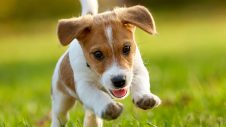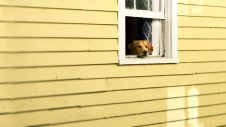by JOHN S JOHNSON
Taking a deep breath your dinner guests smile politely. “Oh, I see you must have gotten a new puppy,” they announce with wrinkled noses, even though the dog is nowhere in sight. The nearly new carpet, once a lovely beige, is beginning to take on a whole new pattern and you are now on the mailing list of every carpet cleaning company in North America.
Without a doubt the single most frustrating problem with a new dog or puppy is the ever-present problem of house training. Nothing seems to be more annoying to the new dog owner or brings down more wrath on the new puppy’s head than house soiling.
Before we begin to tackle this problem, I need to issue a strong note of caution! No program of house training should be started with your puppy or adult dog until you have made a trip to your veterinarian and your canine companion has been given a clean bill of health. No matter how good the program or trainer may be, you can’t train around health problems. Good, balanced nutrition and sound health are essential to both house training and to the growth and happiness of your puppy. So, if you haven’t yet visited the vet, stop reading now, put down the article, call your vet and make an appointment first thing.
What doesn’t work
Let’s look at one or two age-old methods that just don’t work!
The rolled newspaper program isn’t an option unless you are interested in making the puppy develop a fear of the media. Hitting your dog with anything is not a correct method of training.
Another method that has equally disastrous consequences is “rubbing the dog’s nose in the mess and dragging the pup outside”.
Let’s look at two failings of this method. First, think for a moment about how two strange dogs greet each other, that’s right, nose-to-tail as we say. Rubbing the dog’s nose in the mess is a lot more disgusting to humans than to the dog. To your dog it’s kind of like saying hello to himself! The second fault with this method is more of a problem. By reacting to the mess in a loud, negative way we are teaching the dog that humans have this “thing” about faeces and that they had better find a place to go where we won’t find it, such as behind the sofa or in the closet.
Also, keep in mind dogs are “now” animals. They react to what is going on around them at that instant. Correcting the puppy for something which happened several hours ago or even several minutes ago is just not possible. If you don’t catch the dog in the act you can’t correct him for it. So, in this case, the dog doesn’t remember that it’s his mess and would have the same reaction if it were a fake, gag-shop novelty. The dog is simply learning that he doesn’t want to be in the same room with you with any mess.
Now that we know what does not work and we have cleared up some of the myths and questions, let’s house train our puppy.
Prevent Mistakes
We will assume, since you are reading this article with a little more than casual interest, that the puppy in question has already had at least one or two mistakes in the house. This means that we need to back up to day zero and begin again. Dogs are creatures of habit and, with regard to toilet habits, they are triggered by smell. We first need to eliminate the odours coming from, and the availability of, any location the puppy has begun to establish as his bathroom. Clean the area, or areas, in question with a good quality pet soil cleaner and restrict your puppy’s access to these areas until the puppy is trained. Break the old bad habit of the puppy going in an area of its choosing inside the house until we can establish the good habit of going in the designated area outside.
Confinement: The First Rule
A new dog in the household should be confined to those areas where he is likely to cause the least problem until he is trained. Choose the obvious area with non-carpeted floors such as the kitchen, utility room or bathroom. By limiting the damage that the puppy can cause we are also limiting our level of frustration and annoyance during the training period.
Cover the floor or a portion of the floor with newspapers or puppy training pads and encourage the puppy to eliminate on the papered area. It will later be necessary to break this habit and train the dog to go outside in a specified area.
Crate Training
Every time I mention crate training people seem to flinch at the thought of confining their dog to such a small area. Before you rule it out and skip this section, read on. We humans are not used to living in small spaces. Dogs, however, are den animals and find security and comfort in the confines of the small, cosy den. Dogs also have a natural instinct to avoid soiling the den and will develop a strong urge not to soil their sleeping quarters.
So what is a crate and how should training be established? A crate can be either an airline- or a transport-type of container or a wire kennel-type of indoor enclosure established as the sleeping quarters and resting place for your new puppy. In other words, a crate creates a little den inside of your big one.
The size of the adult dog should be taken into consideration when buying a crate. If you need a large size crate for the adult, you’ll want to block off part of it while the pup is small. The space should be big enough for the pup to stand up and turn around, but if it is too large, you run the risk of allowing the puppy to subdivide the area into living room and bathroom.
Under no circumstances should the crate be used as a punishment area. The crate is a den, not a prison. It should be a warm, comfortable area that the puppy enjoys being in, one where he feels secure and safe. The only time the door needs to be closed and locked is for confinement at night or in our absence.
Whenever your puppy has been confined in the crate with the door closed, when he is let out of the crate he should immediately be taken to the toilet area.
Teach And Reward Appropriate Behaviour
An excellent example of the merits of positive versus negative reinforcement in training methods is the experience of house training. There are thousands of places your puppy can choose for its toilet, all of which are wrong and all of which would require him to be corrected each time he used them. There is, however, only one appropriate location where he should be encouraged to go and rewarded for going.
Decide where you want your dog’s toilet to be and then don’t keep it a secret from the puppy. Take your puppy to the toilet area often and praise it enthusiastically whenever it goes to the bathroom in the correct area. A dog biscuit for going to the bathroom may sound silly to us, but it won’t sound silly to the dog.
Pick a corner or area of the back yard, not the entire back yard. From your standpoint it is easier to clean and maintain and you can walk in the rest of the yard without boots.
Establishing a Schedule
One of the physical realities of this problem is that what goes in must, eventually, come out. If we control and schedule input, then we can time and control output.
Dogs should not be “free feeding”. They should be fed on a schedule, as opposed to having food available whenever they choose to eat.
Feed and water on an established schedule. Based on veterinary recommendations and the age of your pet, this can be from once to three times daily. Write it down so it is a fixed schedule that includes feeding, exercise and walks.
If the dog has a medical condition water restriction may be harmful so consult your veterinarian. If it is hot, if your dog is panting, or anytime he has been walked or exercised, your dog should have access to water.
When it is hot, I am willing to risk the occasional puddle to avoid a health risk to my dogs.
Constant Companion
For the first two days of establishing your schedule, your puppy should always be with you during the waking hours. The puppy is either with you or in the crate. By “with you” I mean tethered or tied to you by a leash. This way you can watch him and look for the signs he will exhibit when it is time to relieve himself. If he begins to sniff the floor, walk in circles, whine or squat, take him to his toilet area immediately. Write down the time he goes every time he goes.
In about two or three days you should have a pretty well-established schedule that includes your times for feeding, walking and playing, as well as the puppy’s times for bathroom breaks. If the dog’s urge is thirty minutes after feeding time, then you now know that twenty-five minutes after feeding he had better be out in the toilet area.
You can’t train if you’re not there. If all the adults in the house are working, confine the dog in the restricted, papered area until the weekend and then begin your training procedure. But plan on spending several consecutive days if you want this program to be effective.
Puppy Expectations
If your new canine resident is a puppy, it is important to understand what to expect as normal bladder and bowel control.
At two months of age your puppy will be able to hold bladder and bowel for about two hours maximum. Trained or not, your puppy will relieve himself on this schedule even if you don’t let him out. It is not an accident if he is not given the opportunity to get it right.
This control will gradually increase as your puppy gets older until a well-trained adult dog can hold bladder and bowel control for between eight and twelve hours.
Handling Mistakes When They Happen
Expect occasional accidents. The key word here is occasional. If the accidents are daily you need to re-read it program and re-work your house training.
If you are in the living room and the puppy begins to squat, what should you do? Point at the door and shout, “Outside! Outside! Outside!” and immediately take the puppy to its toilet area. Screaming “No!” to the dog will not override the biological urge and delivers a confusing message to the puppy. “No!” does not tell the puppy what you want, only that you are unhappy. “Outside!” becomes an instructive reprimand that tells the puppy what is wrong and also how to get it right.
Throwing a temper tantrum will have little effective value and hitting your puppy or dog is never appropriate.
If you follow these recommendations and develop an effective house training program your dog or puppy should soon develop a satisfactory and reliable toilet routine that will provide you high satisfaction and make your dog a welcome indoor addition to the family.
John S Johnson is an obedience instructor and an animal behaviour specialist in Colorado Springs, Colorado. He received his training from the San Francisco SPCA.

 Greencross Vets
Greencross Vets 



